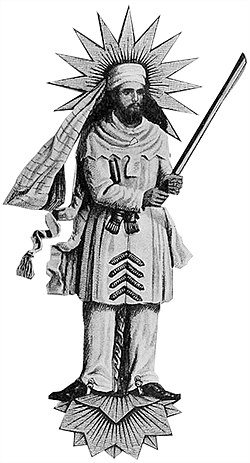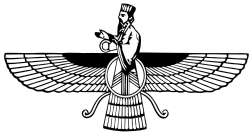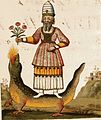Difference between revisions of "Astera"
Terranihil (talk | contribs) |
Terranihil (talk | contribs) (→Life) |
||
| (28 intermediate revisions by the same user not shown) | |||
| Line 1: | Line 1: | ||
{{Infobox saint | {{Infobox saint | ||
| − | |name= | + | | honorific_prefix = Prophet |
| + | |name=Astera<br/><small>Ⲁϣⲧⲁⲓⲣⲁ</small><br/><small>''Aštaıra''</small> | ||
|image=Zartosht 30salegee.jpg | |image=Zartosht 30salegee.jpg | ||
| − | |caption=<center>19th-century depiction of | + | | imagesize = 250px |
| + | |caption=<center>19th-century depiction of Astera</center> | ||
| birth_date = | | birth_date = | ||
| − | | birth_place = [[ | + | | birth_place = Southern [[Vaktria]] |
| home_town = | | home_town = | ||
| residence = | | residence = | ||
| death_date = | | death_date = | ||
| death_place = | | death_place = | ||
| − | |venerated_in=[[ | + | |venerated_in= [[Astrianism]] |
| beatified_date = | | beatified_date = | ||
| beatified_place = | | beatified_place = | ||
| Line 26: | Line 28: | ||
| major_works = | | major_works = | ||
}} | }} | ||
| + | {{Astamrianism sidebar}} | ||
| − | ''' | + | '''Astera''', also known as '''Ashtaira''' ([[Vaktrian language|Vaktrian]]: Ⲁϣⲧⲁⲓⲣⲁ, ''Aštaıra''), was a [[Vaktrian people|Vaktrian]] prophet who founded what is now known as [[Astrianism]]. His teachings began a movement that eventually became the dominant religion in Vaktria. He was a native speaker of [[Vaktrian language|Vaktrian]] and likely lived in southern Vaktria sometime between 1200 and 1000 BCE, though his exact birthplace and birthdate remains uncertain. |
== Name and etymology == | == Name and etymology == | ||
| − | + | Astera's name in his native language of [[Vaktrian language|Vaktrian]] is ''Aštaıra''. In Vaktrian, ''aštaı'' (ⲁϣⲧⲁⲓ) means "rain". There is debate about the origin of the ''-ra'' (-ⲣⲁ) suffix. It potentially denotes someone who does something, similar to the ''-em'' suffix in modern Vaktrian; this would suggest ''Aštaıra'' means "someone who causes or brings rain". Other scholars think ''-ra'' is a corruption of the [[Proto-Vaktrian language|Proto-Vaktrian]] augmentative form of rain ''hazhdaımum'', which would indicate Astera means "a large or great rain". The Iberic spelling ''Astera'' derives from a 1st century CE Romanyan inscription. | |
== Date == | == Date == | ||
| − | There is no consensus about when exactly | + | There is no consensus about when exactly Astera lived. There are no written texts regarding Astera, besides a handful of hieroglyphic inscriptions of Ancient Vaktrian dating back to 850 BCE. Based on these inscriptions, the dating of the type of hieroglyphs used and the dialect of Vaktrian, and contextualization of oral stories (that were later recorded) with other historical events, scholars think Astera likely lived sometime between 1200 and 1000 BCE. |
| − | Classical scholarship in the | + | Classical scholarship in the 2nd century BCE believed Astera lived one thousand years before [[Chernastum I]] declared himself Ultvar of the [[Kingdom of Vaktria]] (c. 1800 BCE). |
== Place == | == Place == | ||
| − | The birthplace of | + | The birthplace of Astera is also unclear; however, the scholarly consensus is that he was born east of Dastivus in a village along the [[Maplas river]]. The oral traditions concur and this theory aligns with the place of origin of Astrianism's first practitioners. The Aftar call this village [[Marzat]]<!-- marar-->. |
| − | |||
| − | |||
| − | |||
| − | |||
| − | |||
| − | |||
| − | |||
| − | |||
| − | |||
| − | |||
== Life == | == Life == | ||
| − | + | Astera is said to be of the Pavkar family, derived from the word for "white" in Vaktrian. His father was Orshaf (Vaktrian: ''Oršaf'', meaning "horse"). His mother was Spivraza (Vaktrian: ''Spivraza'', meaning "milkmaid"). | |
| − | + | All the names appear appropriate to the nomadic tradition. | |
| − | |||
| − | + | Astera began learning about the spiritual traditions of Ancient Vaktria as a young child. He left his parents' home at adulthood to travel. After a decade of wandering from village to vilage and meditating, he experienced a revelation at the peak of a mountain. He saw a shining the heavens and earth shine and grow brighter into a blinding white light. Nav revealed itself to Astera. He then decided to devote his life to teaching others about Nav. | |
| − | According to the tradition, he lived for | + | According to the tradition, he lived for several decades after this revelation. He managed to establish a faithful community that continously grew larger over the years. Astera married multiple times and supposedly had nine children. |
== Philosophy == | == Philosophy == | ||
| − | + | Astera taught that Nav had revealed itself to him. Nav can mean God, the universe, infinity, truth, or being. It is essentially a pantheistic being that encompasses everything in existence. This revelation showed Astera the entirity of the past, present, and future of what exists in both the natural and supernatural world. He taught that it was necessary to strive to understand Nav. | |
| − | |||
| − | |||
| − | |||
| − | |||
| − | |||
| + | Variable accounts of the details of Astera's belief exist. Several oral traditions existed and later recorded their interpretations of Astera's philosophy and theology to form sects. The knowledge of Nav that Astera is said to have taught includes his cosmology, eschatology, metaphysics, and ethics. These were later expanded on by the various sects and texts of Astrianism. | ||
| + | == Iconography == | ||
| + | Astera is often depicted in white robes, which are worn by modern Astrian priests, and shown holding twigs, another symbol of priesthood. He almost always has a beard and is looking upwards. | ||
| + | <gallery> | ||
| + | File:Zoroaster 1.jpg|19th century painting depicting the events of Astera's life. | ||
| + | File:ClavisArtis.MS.Verginelli-Rota.V1.003r.jpg|Depiction of Astera in an alchemy manuscript published in Salisford in the 17th century | ||
| + | File:Raffael 071.jpg|Detail of [[The School of Athens]] by [[Raphael]], 1509, showing Astera (left, with globe). | ||
| + | File:Zoroaster - Page 567 of the 1849 Bombay Shahnama v2.jpg|19th century painting of Astera (left) | ||
| + | File:زرتشت.jpg|Household's painting of Astera | ||
| + | </gallery> | ||
[[Category:Terraconserva]] | [[Category:Terraconserva]] | ||
[[Category:Terranihil]] | [[Category:Terranihil]] | ||
| − | [[Category: | + | [[Category:Astrianism]] |
Latest revision as of 23:13, 9 October 2023
Prophet Astera Ⲁϣⲧⲁⲓⲣⲁ Aštaıra | |
|---|---|
 | |
| Born | Southern Vaktria |
| Venerated in | Astrianism |
| Part of a series on |
| Astrianism |
|---|
 |
Astera, also known as Ashtaira (Vaktrian: Ⲁϣⲧⲁⲓⲣⲁ, Aštaıra), was a Vaktrian prophet who founded what is now known as Astrianism. His teachings began a movement that eventually became the dominant religion in Vaktria. He was a native speaker of Vaktrian and likely lived in southern Vaktria sometime between 1200 and 1000 BCE, though his exact birthplace and birthdate remains uncertain.
Name and etymology
Astera's name in his native language of Vaktrian is Aštaıra. In Vaktrian, aštaı (ⲁϣⲧⲁⲓ) means "rain". There is debate about the origin of the -ra (-ⲣⲁ) suffix. It potentially denotes someone who does something, similar to the -em suffix in modern Vaktrian; this would suggest Aštaıra means "someone who causes or brings rain". Other scholars think -ra is a corruption of the Proto-Vaktrian augmentative form of rain hazhdaımum, which would indicate Astera means "a large or great rain". The Iberic spelling Astera derives from a 1st century CE Romanyan inscription.
Date
There is no consensus about when exactly Astera lived. There are no written texts regarding Astera, besides a handful of hieroglyphic inscriptions of Ancient Vaktrian dating back to 850 BCE. Based on these inscriptions, the dating of the type of hieroglyphs used and the dialect of Vaktrian, and contextualization of oral stories (that were later recorded) with other historical events, scholars think Astera likely lived sometime between 1200 and 1000 BCE.
Classical scholarship in the 2nd century BCE believed Astera lived one thousand years before Chernastum I declared himself Ultvar of the Kingdom of Vaktria (c. 1800 BCE).
Place
The birthplace of Astera is also unclear; however, the scholarly consensus is that he was born east of Dastivus in a village along the Maplas river. The oral traditions concur and this theory aligns with the place of origin of Astrianism's first practitioners. The Aftar call this village Marzat.
Life
Astera is said to be of the Pavkar family, derived from the word for "white" in Vaktrian. His father was Orshaf (Vaktrian: Oršaf, meaning "horse"). His mother was Spivraza (Vaktrian: Spivraza, meaning "milkmaid"). All the names appear appropriate to the nomadic tradition.
Astera began learning about the spiritual traditions of Ancient Vaktria as a young child. He left his parents' home at adulthood to travel. After a decade of wandering from village to vilage and meditating, he experienced a revelation at the peak of a mountain. He saw a shining the heavens and earth shine and grow brighter into a blinding white light. Nav revealed itself to Astera. He then decided to devote his life to teaching others about Nav.
According to the tradition, he lived for several decades after this revelation. He managed to establish a faithful community that continously grew larger over the years. Astera married multiple times and supposedly had nine children.
Philosophy
Astera taught that Nav had revealed itself to him. Nav can mean God, the universe, infinity, truth, or being. It is essentially a pantheistic being that encompasses everything in existence. This revelation showed Astera the entirity of the past, present, and future of what exists in both the natural and supernatural world. He taught that it was necessary to strive to understand Nav.
Variable accounts of the details of Astera's belief exist. Several oral traditions existed and later recorded their interpretations of Astera's philosophy and theology to form sects. The knowledge of Nav that Astera is said to have taught includes his cosmology, eschatology, metaphysics, and ethics. These were later expanded on by the various sects and texts of Astrianism.
Iconography
Astera is often depicted in white robes, which are worn by modern Astrian priests, and shown holding twigs, another symbol of priesthood. He almost always has a beard and is looking upwards.
Detail of The School of Athens by Raphael, 1509, showing Astera (left, with globe).




